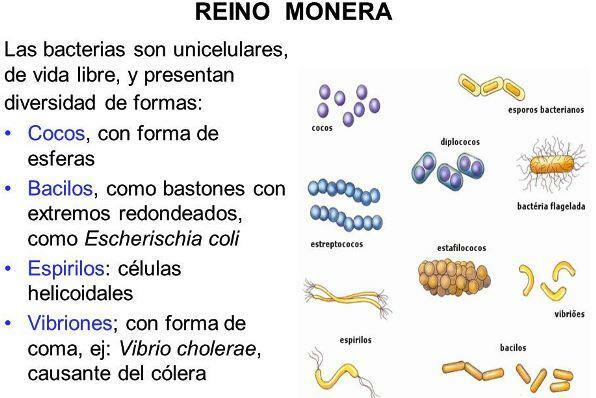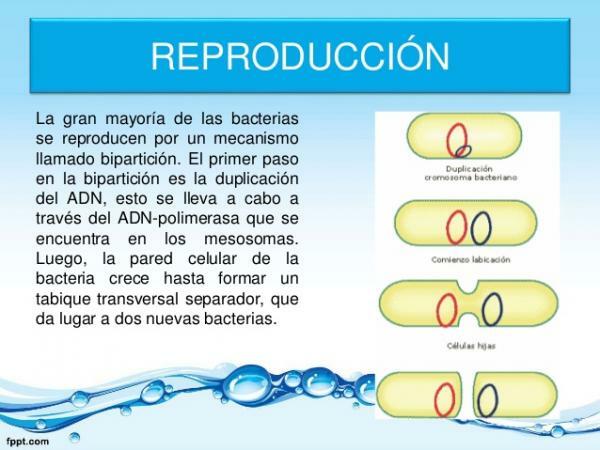Characteristics and examples of the MONERA KINGDOM

Image: Google Sites
According to a classic classification, devised in the 1970s and still used by some in the Today, the organisms of the entire planet can be classified into: protists, monera, fungi, plants and animals. The term monera currently used for refer to prokaryotes, that is, to those animals whose cells lack internal cell envelopes and organelles and more specifically, lack a nucleus. In this lesson from a TEACHER we will see the monera kingdom: characteristics and examples. We will learn more about prokaryotic organisms and give examples, especially some very important to humans. If you want to know more, keep reading!
Index
- The monera kingdom: what are its cells like?
- Characteristics of the monera kingdom: the organisms
- The nutrition of prokaryotes: autotra or heterotrophs
- Where can prokaryotes live?
- The reproduction of monera organisms
The monera kingdom: what are its cells like?
Within the classical classification of organisms, the most primitive kingdom is the Monera Kingdom. Currently, the organisms of the Monera kingdom are called
prokaryotes and we can find two groups: bacteria and archaea.Prokaryotes are characterized by being beings unicellular, which do not group together to form tissues. Each of the individuals is made up of a single cell or at most they are grouped together, but in no case is there communication or cooperation to carry out their vital functions. These cells are very simple and do not have any type of compartment or inner membrane. They are simply a sac in which DNA, proteins and other substances that make up the cell are free through the cytoplasm.
If you want to know more about the parts of prokaryotic cells or its differences with eukaryotic cellsCheck out our previous TEACHER lesson! You will surely find them very interesting!

Image: Monera Kingdom
Characteristics of the monera kingdom: the organisms.
As we have mentioned before, prokaryotes are unicellular organisms so they are microscopic. The organisms of the Monera kingdom have a size between 0.2 and 3 microns in diameter.
Regarding their movement, some prokaryotes do not move while others use cilia or flagella And they can be surprisingly fast! In relation to their size, some species of archaea can travel up to 500 times the size of their body in a second and they can do it following different patterns of movement: straight line, curves, zig-zag, etc.
Closely related to the type of movement is its shape. There are prokaryotes of various shapes: round, elongated, comma, helix, or rod-shaped. There are almost as many ways as you can imagine! An example of a rare form is Treponema pallidum, a prokaryote of the group of spiral or corkscrew-shaped spirochetes that causes the disease of syphilis in humans.

Image: Slideshare
The nutrition of prokaryotes: autotrophs or heterotrophs.
One of the characteristics of the monera kingdom is that its nutrition is very varied. Within the prokaryotes there are organisms autotrophs, which obtain their majority through mechanisms very similar to the photosynthesisof plants although with different pigments and conditions of temperature, pressure, lighting, etc. very different.
In those places where sunlight does not reach, there may be prokaryotes that carry out the chemosynthesis, a process similar to photosynthesis but that uses inorganic chemicals as an energy source. An example of this type of bacteria that has great importance for the planet in general are the nitrogen fixing bacteria. These types of bacteria live in the soil and convert nitrogen from the air into nitrate, necessary so that plants can grow and nitrogen levels in the earth's atmosphere are maintained stable.
As for the heterotrophs, most are:
- Saprophytes: they feed on decomposing organic matter (dead leaves, corpses, excrement, etc.) An example of saprophytic bacteria is Streptococcus sanguis, which inhabits the mouth of human beings and feeds on the remains of food between our teeth, creating bacterial plaque
- Parasites: they feed on the tissues or fluids of other living organisms
- Symbiotic: they feed on another living organism, in exchange for that other organism also benefits from the relationship. An example is that described among some methylobacteria and algae of the genus Chlamydomonas: Methylobacteria are responsible for taking nitrogen and converting it into ammonia, a form of nitrogen much simpler than these algae are capable of assimilate while algae provide them with glycerol, a form of carbon that these bacteria feed on to replace carbon dioxide. carbon.

Image: Google Sites
Where can prokaryotes live?
Prokaryotes can live in many different environments: aquatic, terrestrial or even parasites. This is an important feature of the Monera kingdom as some species of Halobacterium, a genus of prokaryotes, can live even in the Dead Sea, where there are large concentrations of salt while others like Escherichia coli they live within our gastrointestinal tract. Escherichia coli Normally they help us to carry out digestion correctly but on some occasions it can cause strong urinary infections or even in the circulatory and nervous system. Some prokaryotes can withstand not only extreme salinity conditions but also extreme temperatures, high pressures, etc.
This is largely due to the fact that these organisms have: a capsule that surrounds your body, resistance structures, which allow them to resist temporary or temporary adverse conditions and defense substances to eliminate possible predators. On the one hand, the polysaccharide capsule that surrounds their cell membrane protects them against phagocytosis of different organisms (including cells of the human immune system).
Also, when environmental conditions are too difficult to survive, these prokaryotes take their DNA and a small portion of cytoplasm and surround it with a protective wall, very strong and resistant and with a large amount of calcium, forming a structure called endospore. Endospores are resistant to years of freezing, desiccation, chemical solvents, radiation, and even crushing!
Finally, and when they have no choice, the organisms of the Monera kingdom are able to manufacture toxic substances. An example is actinobacteria Streptomyces griseus, which generates a very specific natural antibiotic that attacks certain types of infections and was widely used to treat tuberculosis.
The reproduction of monetary organisms.
Another important feature of the Monera kingdom is its reproduction. The organisms of the Monera kingdom reproduce from asexual form throughbipartition or Binary fission: mostly. When the bacterium or archaea is large enough and conditions are good, the cell copies its DNA (duplication), and divides the cell's cytoplasm into two parts (cytokinesis). Each of the two parts is left with a copy of DNA and, at the end of cytokinesis, two cells equal to the original cell are obtained.
These forms of reproduction allow them to generate many, many copies of the original organism in a very short time. The new organisms will be clones of the original except when errors occur during the copying of the individual's genetic material (mutations). For this reason, as an accessory to reproduction, they may sometimes appear mechanisms for exchanging genetic material which can be of three types: conjugation, transduction and transformation.

Image: Slideshare
If you want to read more articles similar to Monera kingdom: characteristics and examples, we recommend that you enter our category of biology.
Bibliography
- Margulis, L. & Schwartz, K. V. (1982). Five Kingdoms. An Illustrated Guide to the Phyla of Life on Earth. W.H. Freeman, San Francisco.
- Whittaker, R. H. (1969). New concepts of kingdoms of organisms. Science 163: 150-160.
- Bioencyclopedia. (s.f) Monera Kingdom. Recovered from https://www.bioenciclopedia.com/reino-monera/
- Rodriguez, D. (s.f) Monera Kingdom: Characteristics, Classification and Examples. Leader. Recovered from https://www.lifeder.com/caracteristicas-reino-monera/
- IDesqbre (February 15, 2018). They discover a form of symbiosis between a bacterium and a type of unicellular alga. Recovered from https://idescubre.fundaciondescubre.es/noticias/descubren-una-forma-simbiosis-una-bacteria-tipo-alga-unicelular/
